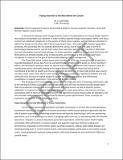Paying Attention to the Man behind the Curtain
Author(s)
Cummings, M. L.; Thornburg, Kristopher M.
DownloadCummings_paying attention.pdf (725.1Kb)
OPEN_ACCESS_POLICY
Open Access Policy
Creative Commons Attribution-Noncommercial-Share Alike
Terms of use
Metadata
Show full item recordAbstract
In the push to develop smart energy systems, designers have increasingly focused on systems that measure and predict user behavior to effect optimal energy consumption. While such focus is an important component in these systems' success, designers have paid substantially less attention to the people on the other side of the energy system loop-the supervisors of power generation processes. Smart energy systems that leverage pervasive computing could add to these supervisory control operators' workload. They'll have to predict possible power plant load and production changes caused by environmental and plant events, as well as dynamic system adaptation in response to consumer behaviors. Contrary to many assumptions, inserting more automation, including distributed sensors and algorithms to postprocess data, won't necessarily reduce operators' workload or improve system performance.
Date issued
2011-01Department
Massachusetts Institute of Technology. Department of Aeronautics and Astronautics; Massachusetts Institute of Technology. Humans and Automation LabJournal
IEEE Pervasive Computing
Publisher
Institute of Electrical and Electronics Engineers
Citation
Cummings, Mary L, and K M Thornburg. “Paying Attention to the Man behind the Curtain.” IEEE Pervasive Computing 10, no. 1 (January 2011): 58-62.
Version: Author's final manuscript
Other identifiers
INSPEC Accession Number: 11704510
ISSN
1536-1268
1558-2590